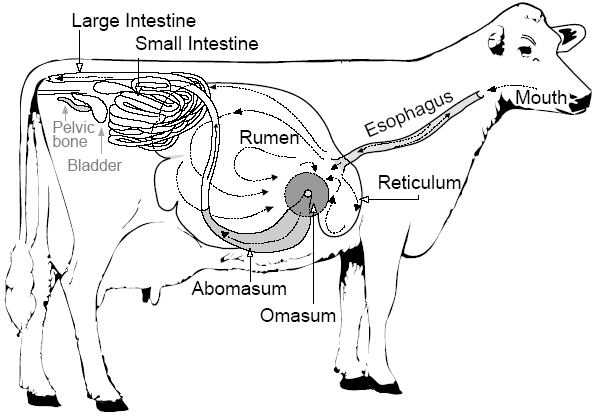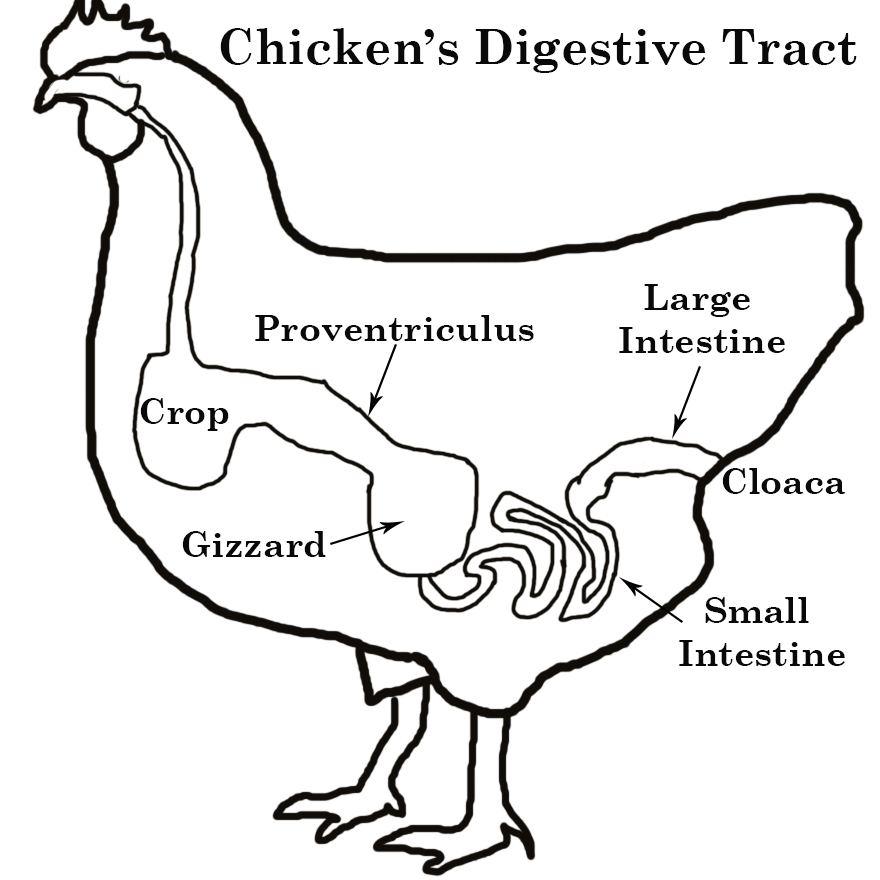Digestion in livestock and poultry

Cow’s digestive system
The cow’s digestive system is specialized for breaking down complex plant materials like cellulose and converting them into usable nutrients. Here’s an overview of the system and its key functions:
- Mouth and Esophagus
- Mouth: The cow’s mouth is equipped with large, flat molars for grinding feed. Cows are selective eaters and chew their food thoroughly before swallowing.
- Esophagus: After the food is chewed, it moves down the esophagus to the stomach. The cow’s esophagus allows for the regurgitation of food, which is essential for rumination (cud chewing).
- Stomach
The cow’s stomach is a complex, four-compartment structure designed for fermentation and digestion of fibrous plant materials.
- Rumen:
- Structure: The largest compartment, located on the left side of the cow. It holds up to 25 gallons of material.
- Function: It serves as a fermentation vat where microbes break down cellulose and other fibrous plant materials. Microbial fermentation produces volatile fatty acids (VFAs) like acetic, propionic, and butyric acids, which provide energy to the cow.
- Microbial Population: Bacteria, protozoa, and fungi in the rumen ferment feed, breaking it down into simpler compounds.
- Eructation (Belching): Gases (mainly methane and carbon dioxide) are produced in the rumen and must be expelled by belching to avoid bloating.
- Reticulum:
- Structure: Located near the rumen and has a honeycomb-like structure.
- Function: Works in conjunction with the rumen for fermentation. It also helps to regurgitate food (cud) for further chewing (rumination).
- Omasum:
- Structure: A globe-shaped compartment with layers of tissue resembling pages in a book.
- Function: Absorbs water and other substances from the partially digested feed. It helps in reducing the particle size of the feed.
- Abomasum (True Stomach):
- Structure: The only glandular compartment, similar to the stomach of non-ruminants.
- Function: It secretes hydrochloric acid and digestive enzymes to further break down food. This is where protein digestion begins, similar to digestion in monogastric animals (like humans).
- Small Intestine
- The small intestine is where most of the final digestion and nutrient absorption takes place.
- Structure: It is about 20 times the length of the cow’s body and is divided into three sections: the duodenum, jejunum, and ileum.
- Function: The pancreas and gallbladder release enzymes and bile into the small intestine to aid in digestion. The villi (finger-like projections) in the small intestine absorb nutrients like amino acids, fatty acids, and glucose into the bloodstream.
- Cecum and Large Intestine
- Cecum: Located at the junction of the small and large intestines. Some fermentation of undigested fiber occurs here, although it is not as significant as in the rumen.
- Large Intestine: It absorbs water from the remaining digestive content. Some bacterial digestion of undigested feed also takes place in the large intestine.
Key Digestive Functions
- Rumination: The cow spends a significant amount of time chewing cud. This process allows for further breaking down of feed particles to increase digestibility.
- Saliva Production: The cow produces up to 60-70 liters of saliva per day. Saliva buffers the rumen, helping to maintain an optimal pH (between 6.2 and 6.8) for microbial digestion. It also provides moisture for the microbial population and recycles nitrogen and minerals.
- Fermentation: In the rumen, microbes ferment fiber and produce volatile fatty acids (VFAs), which provide the cow with energy.
- Protein Digestion: Some proteins are broken down in the rumen by microbes, and the ammonia produced is used for microbial growth. Feed protein that bypasses the rumen is digested in the abomasum and small intestine.
Digestive System of a Calf
- At birth, a calf’s rumen, reticulum, and omasum are underdeveloped. The abomasum is the largest compartment and functions as the primary site for digestion.
- The calf’s milk bypasses the rumen via the esophageal groove, which prevents milk from entering the rumen. This groove eventually closes as the rumen begins to develop, typically around 3-4 weeks of age.
- As the calf matures, the rumen begins functioning like an adult cow’s, and it starts to utilize fibrous feeds.
The digestive system of poultry

The digestive system of poultry, such as chickens, is quite different from ruminants like cows. Poultry are monogastric animals, meaning they have a single-chambered stomach. Here’s an overview of their digestive system and its functions:
- Beak and Mouth
- Beak: Unlike mammals, poultry do not have teeth. The beak is used for pecking at food, and the food is broken down into smaller pieces in the mouth.
- Salivary Glands: Poultry have salivary glands that secrete saliva to moisten the food, but they don’t have enzymes like mammals do. The saliva helps in the swallowing process.
- Tongue: Poultry have a small, relatively simple tongue that aids in moving food toward the esophagus.
- Esophagus
- Structure: The esophagus is a long tube that connects the mouth to the crop.
- Function: It serves as a conduit for food, moving it from the mouth to the crop, where it is temporarily stored before being digested further.
- Crop
- Structure: The crop is an expanded, pouch-like section of the esophagus.
- Function: The crop temporarily stores food before it enters the stomach. It also moistens and softens food, making it easier to digest later. In some cases, food can be regurgitated from the crop for additional chewing or mixing with saliva.
- Proventriculus (Glandular Stomach)
- Structure: The proventriculus is the first part of the stomach and is a tubular structure.
- Function: It secretes digestive enzymes (such as pepsin) and hydrochloric acid to break down proteins in the food. The proventriculus serves as the site of chemical digestion, much like the human stomach
.
- Ventriculus (Gizzard)
- Structure: The gizzard is a muscular, thick-walled organ that is located just after the proventriculus.
- Function: The gizzard mechanically grinds and crushes food. Poultry often swallow small stones or grit that help in this grinding process, as they lack teeth. This is crucial for breaking down fibrous and hard materials, like seeds and grains, into smaller, digestible particles.
- The gizzard also mixes the food with digestive enzymes from the proventriculus to facilitate digestion.
- Small Intestine
- Structure: The small intestine in poultry is divided into three parts: the duodenum, jejunum, and ileum.
- Function: The small intestine is the main site for digestion and absorption of nutrients.
- Duodenum: In the duodenum, bile from the liver and digestive enzymes from the pancreas mix with the food to continue breaking it down. Bile helps emulsify fats, while pancreatic enzymes break down proteins, carbohydrates, and fats.
- Jejunum and Ileum: These sections of the small intestine are primarily responsible for absorbing the nutrients from the digested food into the bloodstream through villi (finger-like projections in the lining of the intestine). Nutrients such as amino acids, fatty acids, glucose, vitamins, and minerals are absorbed here.
- Ceca (Cecum)
- Structure: Poultry have two ceca (plural of cecum), which are blind pouches located between the small and large intestines.
- Function: The ceca serve as sites for fermentation. Though not as developed as in ruminants or herbivores, the ceca allow some fermentation of undigested feed, especially fiber. Microorganisms in the ceca help break down complex carbohydrates, and volatile fatty acids (VFAs) produced in the ceca can be absorbed for energy. The ceca also play a role in the absorption of water, electrolytes, and some vitamins.
- Large Intestine
- Structure: The large intestine is relatively short compared to that of mammals.
- Function: The primary function of the large intestine in poultry is the absorption of water and electrolytes from the remaining indigestible food material. This process helps prevent dehydration. The large intestine also stores waste before it is excreted.
- Unlike in mammals, the large intestine does not play a significant role in digestion.
- Cloaca
- Structure: The cloaca is a single exit point for the digestive, urinary, and reproductive systems.
- Function: It serves as the passage through which waste products (feces and urine) are excreted. In poultry, feces and urine are excreted together as a semiliquid mixture, and the cloaca serves to eliminate both solid and liquid waste.

